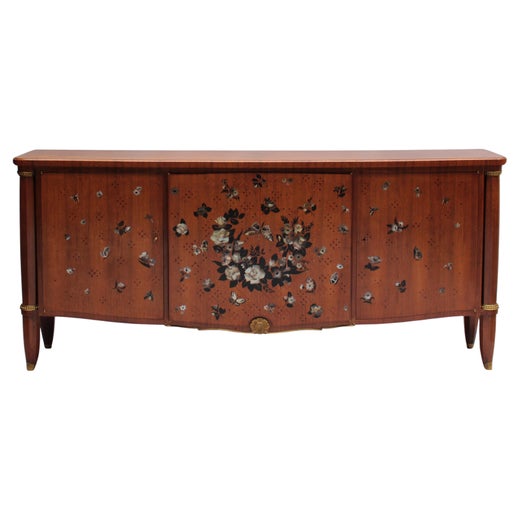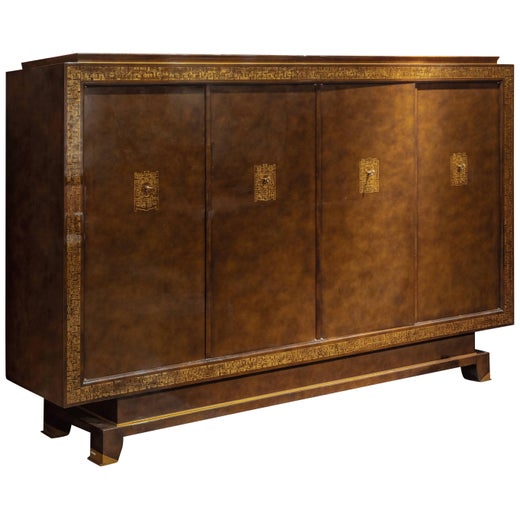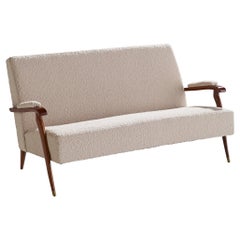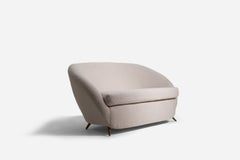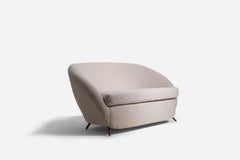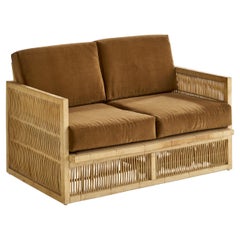Jules Leleu, Modernist Settee, Mahogany, Brass, Bouclé, 1960s, France
About the Item
- Creator:Jules Leleu (Designer),Maison Leleu (Cabinetmaker)
- Dimensions:Height: 30 in (76.2 cm)Width: 57 in (144.78 cm)Depth: 30 in (76.2 cm)Seat Height: 15.5 in (39.37 cm)
- Style:Modern (Of the Period)
- Materials and Techniques:
- Place of Origin:
- Period:
- Date of Manufacture:circa 1960
- Condition:Wear consistent with age and use. Light patina to wood. Reupholstered in brand new high end bouclé.
- Seller Location:High Point, NC
- Reference Number:Seller: 29751stDibs: LU3228115521371
Jules Leleu
A designer and ensemblier, Jules Leleu was one of the key authors of the Art Deco movement. While he did not win the fame of such contemporaries as Émile-Jacques Ruhlmann and Jean-Michel Frank, Leleu had a longer career and was easily their peer in the conception of trim, refined furniture forms and in the use of the opulent materials — from lacquer and ivory to sharkskin and exotic woods — that were a keynote of haute Art Deco design.
Leleu was born into a family of artisans and decorators. Their firm, Maison Leleu, had existed since the 18th century and Jules would guide it through much of the 20th. (The business lasted until 1973, headed at the end by Jules's children.) He studied architecture, served as an aviator in World War I, and after the conflict took up design full-time.
Leleu presented work at the 1925 exposition in Paris that gave us the term Art Deco, and the Metropolitan Museum of Art in New York purchased a burl amboyna wood commode by Leleu directly from the show.
As the desks, dining tables and other furniture on 1stDibs show, Leleu was a stickler for precision craft and preferred to let his materials do the talking — his furniture is generally spare and sleek; its presence is established by figuring (or patterning/graining) in the wood and the occasional marquetry medallion. He had a keen eye for currents in design and an adaptable sensibility.
Maison Leleu would embrace many of the starker forms of modernism after the 1940s, as well as new materials such as artificial lacquer and plastics (then considered cutting-edge rather than cheap). Jules Leleu is a guiding light of 20th-century modernism: a man whose work represents both a devotion to traditional handiwork and an appreciation for the next wave in design.
Find Jules Leleu tables, sideboards, dining chairs and other furniture on 1stDibs.
Maison Leleu
Jules Leleu founded Maison Leleu with his brother Marcel in Paris in 1910. The firm specialized in interior design projects and furnishings created in the era’s luxurious Art Deco style for residential and commercial spaces around the world. There were plush sofas, sleek walnut cabinets that featured marquetry and brass door pulls, and stately coffee tables with bases that terminated with substantial bronze sabots.
A designer and ensemblier, Jules was one of the key authors of the Art Deco movement. While he did not win the fame of such contemporaries as Émile-Jacques Ruhlmann and Jean-Michel Frank, Leleu had a longer career and was easily their peer in the conception of trim, refined furniture forms and in the use of opulent materials — from lacquer and ivory to sharkskin and exotic woods — that were keynotes of haute Art Deco design.
Marcel and Jules’s clientele included President Eisenhower, the Ecuadorian ambassador to France and Prince Pierre of Monaco, who favored Maison Leleu’s Directoire-inspired designs. Jules’s children, André, Paule and Jean worked at the family business expanding their reach to include projects that encompassed luxury passenger ship interiors and even so far as the United Nations office in Geneva, Switzerland, as well as the private residences of royalty. Maison Leleu would embrace many of the starker forms of modernism after the 1940s, as well as new materials such as artificial lacquer and plastics (then considered cutting-edge rather than cheap).
Maison Leleu closed its doors, somewhat mysteriously, in 1973.
Alexia, Jean’s granddaughter, pursued a career in pharmaceuticals but her family history always nagged at her. Why would such a successful company close its doors and walk away from it all? By meeting with her great-grandfather’s secretary, Françoise Siriex, Alexia discovered a contract between Maison Leleu and the Shah of Iran from 1969. Maison Leleu spent the subsequent three years designing and producing over 50 displays for an event that marked the anniversary of the founding of the Persian Empire, but in a devastating one-two punch, the Shah didn’t pay for the work and the Iranian Revolution put any hopes out of reach. To avoid bankruptcy, Maison Leleu disappeared.
As of 2018, Alexia has reignited the old flame and is restoring the company back to its former glory. With a strong focus on her heritage and qualities that rendered Maison Leleu exemplary — refinement and timeless design — the new Maison Leleu offers furniture, lighting and rugs and has secured partnerships with luxury brands Louis Vuitton and Cartier as well as Claridge’s Hotel.
One 1stDibs, find a collection of antique Maison Leleu seating, tables and storage case pieces.
You May Also Like
Vintage 1960s French Loveseats
Bronze
Vintage 1960s Danish Mid-Century Modern Settees
Teak, Leather
Mid-20th Century American Louis XV Loveseats
Mahogany
Vintage 1950s Settees
Metal
Vintage 1940s French Loveseats
Fabric, Hardwood
Antique 1880s French Victorian Settees
Fabric, Mahogany
20th Century American Mid-Century Modern Loveseats
Fabric, Mahogany
Vintage 1970s Unknown Mid-Century Modern Settees
Brass
Early 20th Century French Art Deco Loveseats
Velvet, Wood
Vintage 1930s European Louis XV Settees
Walnut
More From This Seller
View AllVintage 1960s French Modern Sofas
Brass
Vintage 1950s Italian Mid-Century Modern Sofas
Brass
Vintage 1950s Italian Mid-Century Modern Sofas
Brass
Vintage 1960s American Mid-Century Modern Settees
Velvet, Bamboo, Oak
Vintage 1950s American Mid-Century Modern Settees
Fabric, Mahogany
Vintage 1950s Italian Mid-Century Modern Settees
Brass
